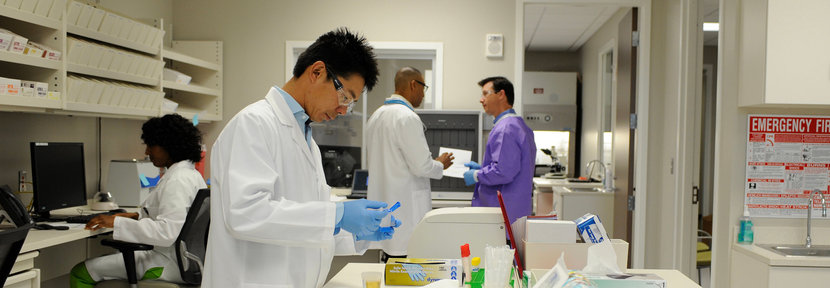Lesedauer von 6 Min.
03. Februar 2025
ATEMWEGSGESUNDHEIT
Experten-Perspektive
Tests auf Atemwegserkrankungen: Vorbereitung auf eine ungewisse Zukunft
Das weltweite Auftreten von COVID-19 führte zu einem radikalen Wandel im Management von Patienten mit Atemwegserkrankungen und/oder grippeähnlichen Symptomen, wie z. B. Fieber, Unwohlsein und Myalgien. In der Vergangenheit hätten solche Symptome als mit einer Influenza- oder Respiratorischen Synzytial-Virusinfektion vereinbar interpretiert werden können, unter den aktuellen Bedingungen wird SARS-CoV-2 jedoch häufig als Differentialdiagnose in Betracht gezogen. Derzeit wird ein Patient mit diesen Symptomen wahrscheinlich einfach zu Hause einen Antigen-Schnelltest durchführen oder sich in einem Versorgungszentrum oder Krankenhaus vor Ort testen lassen. Ein negatives Ergebnis für COVID-19 könnte dem Patienten jedoch ein falsches Gefühl von Sicherheit vermitteln, während seine Symptome tatsächlich durch etwas Schwerwiegendes, wie z. B. die Grippe, verursacht werden.
SARS-CoV-2 hat die Art und Weise verändert, wie Atemwegspatienten vom Gesundheitssystem gemanagt werden und wie die Allgemeinbevölkerung auf diese Symptomatik reagiert. Dieser Artikel befasst sich mit dieser sich wandelnden klinischen Landschaft und untersucht, wie die aus früheren Virusausbrüchen gewonnenen Erkenntnisse angewendet wurden, um schnelle und präzise molekulare Tests zu entwickeln, die nicht nur dazu beitragen, COVID-19 rasch zu diagnostizieren, sondern auch „variantenbereite“ Lösungen für den Nachweis von SARS-CoV-2, Influenza A und B und anderen Viren bereitzustellen, die ähnliche Symptome verursachen können.
Die globale Belastung durch respiratorische Erkrankungen
Atemwegsviren haben seit langer Zeit Auswirkungen auf die menschliche Gesundheit, aber selten haben sie unseren Alltag in einer Weise beeinträchtigt wie SARS-CoV-2. Die Coronavirus-Familie ist dem Menschen nicht fremd, und die meisten Stämme verursachen in der Regel nur leichte Erkrankungen der oberen Atemwege, wie z. B. Erkältungen. Gelegentlich treten jedoch neue Stämme auf, die tödlicher sind, wie MERS-CoV oder SARS-CoV, oder ansteckender wie SARS-CoV-2.1 Glücklicherweise ist die allgemeine Natur dieser Viren darauf ausgelegt, sich anzupassen, so dass diese Viren dann weniger pathogen sind. Neue Varianten mit unterschiedlicher Übertragbarkeit und Schwere werden weiterhin auftreten, aber im Laufe der Zeit werden sich die dominanten Stämme wahrscheinlich eher den anderen endemischen zirkulierenden Coronaviren angleichen und damit leichtere Symptome verursachen. Da dies der natürliche Verlauf ist, sollten die aktuellen Impf- und Boosterprogramme sowie die natürliche Immunität, die sich nach abgeklungenen Infektionen einstellt, einen zunehmenden Schutz vor schweren Erkrankungen bieten.
Bei Influenza ist eine ähnliche Entwicklung zu verzeichnen, allerdings verursacht diese weltweit immer noch eine signifikante Mortalität und Morbidität. Saisonale Stämme infizieren jedes Jahr Millionen von Menschen und sind für Hunderttausende von Todesfällen verantwortlich; eine Studie berichtete zwischen 1999 und 2015 jährlich über 290.000 bis 650.000 saisonale influenzaassoziierte Todesfälle infolge von Atemwegserkrankungen.2 Wie alle Viren verändert sich auch das Influenza-Virus ständig, um überleben und seine Wirte leichter infizieren zu können. Gelegentlich treten Stämme auf, die einen öffentlichen Gesundheitsnotstand auslösen, wie z. B. der Influenza-A-Subtyp H1N1. Das Virus war für die Pandemien 1918 und 2009verantwortlich, wobei erstere zu schätzungsweise 50 Millionen Todesfällen weltweit führte.3
Die rasche Veränderung dieser Viren bedeutet, dass sich auch die Diagnostik-Tools kontinuierlich anpassen und weiterentwickeln müssen, um die Ärzte bei der Behandlung ihrer Patienten unterstützen zu können. Die Folgen einer Fehldiagnose können gravierend sein. Die daraus resultierende Unwirksamkeit von Therapien kann zu schwereren Symptomen und zur Krankheitsprogression führen, da der ursächliche Erreger der Behandlung entgeht.
Mit dem Aufkommen antiviraler Therapien, die wirksamer sind, wenn sie in einem frühen Stadium der Krankheit verabreicht werden, ist der Bedarf an schnellen, empfindlichen und zuverlässigen Ergebnissen dringender denn je.
Entwicklung robuster diagnostischer Tests
Molekulare Methoden bleiben der Goldstandard für die Diagnostik von Atemwegsinfektionen im klinischen Setting. Für COVID-194 sind schnelle Antigentests bei symptomatischen Patienten mit hoher Viruslast angezeigt; sie verlieren aber an Genauigkeit, wenn beim betreffenden Patienten die Peak-Replikation noch nicht erreicht ist.5 Viele dieser Patienten kommen etwa eine Woche nach dem ersten Auftreten der Symptome mit entzündlichen Komplikationen und in der Regel mit geringerer Viruslast in die Klinik, und dies kann bei einem schnellen Antigentest zu einem negativen Ergebnis führen.
Die Entwicklung und Herstellung molekularer Tests ist ein komplizierter, mehrstufiger Prozess, der normalerweise mit einem ungedeckten klinischen Bedarf beginnt. Diagnostik-Unternehmen beurteilen, wo sie die größte Wirkung erzielen können und untersuchen, welche Tests erforderlich sind, um Ärzten, Mikrobiologen oder Spezialisten für Infektionskontrolle dabei zu helfen, Patienten schnell und präzise zu diagnostizieren. Für das Design eines Tests ist jedoch nicht nur die Meinung eines Unternehmens ausschlaggebend. Verschiedene Fachgruppen – Ärzte, Pflegekräfte, Apotheker, Virologen, Spezialisten für öffentliche Gesundheit und Zulassungsbehörden – tragen mit ihren Erfahrungen dazu bei, dass der entwickelte Test den relevanten klinischen Bedarf erfüllt. Es dauert in der Regel mehrere Jahre, ein Produkt zu entwickeln und auf den Markt zu bringen, beginnend beim ersten Assay-Design über die Optimierung bis hin zur Validierung mit dem Nachweis der Genauigkeit. Die Daten werden dann bei einer Aufsichtsbehörde, wie z. B. der FDA, eingereicht, und nach Erteilung der Zulassung kann der Test unter strengen Qualitätskontrollen hergestellt und schließlich Laboren und anderen Gesundheitseinrichtungen zur Verfügung gestellt werden und damit fortan dem klinischen Bedarf Rechnung tragen.
Innerhalb dieses intensiven Prozesses ist es von entscheidender Bedeutung, dass ein Produkt entwickelt wird, welches auch dem Faktor Zeit standhält; dies bedeutet im Falle vieler Viren, dass die ständige Veränderung und Anpassung des Zielpathogens berücksichtigt werden muss. Um bei Infektionskrankheiten einen Schritt voraus zu sein, müssen diagnostische Tests den klinischen Anforderungen von heute und, was entscheidend ist, dem Entwicklungsdruck von morgen standhalten. Wenn wir nicht ausreichend Informationen über einen Erreger oder Kenntnisse über eine Krankheit besitzen, können diese Anforderungen möglicherweise nicht erfüllt werden. In den meisten Fällen können die aus früheren Ausbrüchen gewonnenen Erkenntnisse oder das Wissen über andere Organismen glücklicherweise in die Entwicklung künftiger Instrumente einfließen.
Vorbereitung von molekularen Tests für die Zukunft
RNA-Viren sind anfällig für zufällige Gendrift, die Teil ihrer adaptiven Überlebensfähigkeit ist. Dies wurde beim Auftreten mehrerer Varianten von SARS-CoV-2 beobachtet, die jeweils unter dem Selektionsdruck in bestimmten Populationen oder aus Variationen entstanden sind, die in Regionen des Virus auftraten, welche keiner Immunselektion unterliegen. Diese weitreichenden evolutionären Veränderungen geben dem Virus einen Überlebensvorteil und können den Nachweis neuer Varianten erschweren, wenn die Tests nicht für solche Varianten konzipiert sind.
Dieses Problem trat während der 2009 Influenza-Pandemie auf, als Tests für ein einzelnes Antigenziel entwickelt worden waren, das später eine Gendrift aufwies. Viele Diagnostik-Unternehmen hatten Schwierigkeiten, mit diesem Ausbruch Schritt zu halten, und die Sensitivität von schnellen Antigentests nahm aufgrund von innerhalb des Proteinziels auftretenden Varianten rapide ab, was dazu führte, dass viele Patienten nicht diagnostiziert wurden.7 Tatsächlich sahen sich die Centers for Disease Control and Prevention in den USA angesichts der schlechten Leistung diagnostischer Tests zum Nachweis von Influenza in 2009 und 2010 dazu veranlasst, die Verwendung dieser Tests nicht zu empfehlen.8 Innerhalb eines Einzelziels wird es immer einen kleinen Anteil von Variationen geben, die in mehreren Fällen der Detektion entgehen. Leider ist es schwierig vorherzusagen, wann und wo genetische Variationen auftreten werden und wie schnell diese Veränderungen ablaufen werden. Die diagnostischen Methoden müssen dies folglich berücksichtigen.
In Auswertung des H1N1-Ausbruchs entwickelte Cepheid einen Test, der mehrere unabhängige und konservierte Influenza-A-Ziele ins Visier nimmt, so dass sich die Wahrscheinlichkeit verringert, dass künftige Influenzastämme dem Nachweis entgehen. Dieser Test wurde zu einem Assay entwickelt, der nicht nur saisonale Influenza nachweist, sondern auch zukünftige Influenzastämme von pandemischer Bedeutung, wie H5N1, H7N9 und Vogelgrippe, sowie das Respiratorische Synzytial-Virus (RSV) nachweisen wird. Damit steht eine ausgereiftere Screening-Lösung zur Verbesserung des Patientenmanagements zur Verfügung.
Dieses technologische Know-how und diese Erfahrungen erwiesen sich als entscheidend, als SARS-CoV-2 auftauchte und beschleunigten die Entwicklung des Xpert® Xpress CoV-2/Flu/RSVplus-Tests, der eine kombinierte Screening-Option für SARS-CoV-2, RSV, Influenza A und Influenza B in einer einzigen, verschlossenen Kartusche für das GeneXpert®-System bietet. Diese Lösung hilft bei der schnellen Diagnose von Patienten mit unspezifischen Symptomen der oberen Atemwege oder wenn Ärzte vermuten, dass einer dieser Erreger vorhanden ist und fördert eine zielgerichtetere Vorgehensweise und ein schnelles Patientenmanagement.
Um die Anzahl der Varianten zu minimieren, die dem Nachweis entgehen könnten, beinhaltet dieser Test mehrere Ziele für jedes Virus.
Diese Methode bietet eine mit den Referenzlabors vergleichbare Genauigkeit, kann aber patientennah und nicht zentral durchgeführt werden. Der Test trägt dazu bei, falsch-negative Ergebnisse in der Gegenwart zu vermeiden, wird aber auch in Zukunft wirksam bleiben und sicherstellen, dass betroffene Patienten die medizinische Versorgung oder Beratung erhalten, die sie benötigen. Eine hohe Sensitivität trägt nicht nur zur Verbesserung der individuellen Patientenversorgung bei, sondern hilft auch zu vermeiden, dass Personen ihre Infektion unwissentlich verbreiten und damit andere potenziell gefährden und den Druck auf die öffentlichen Gesundheitsdienste weiter erhöhen.
Entwicklung langlebiger molekularer Tests
Wir können es uns nicht leisten, auf die nächste Pandemie unvorbereitet zu sein und versuchen daher, reaktiv zu handeln und einen neuen Test von Grund auf zu entwickeln, wenn wir mit einem neu auftretenden Erreger konfrontiert werden. Dieser robuste technologische Ansatz wird in der Molekulardiagnostik die Grundlage bilden für die Erstellung von Tools zur Bekämpfung eines potenziellen SARS-CoV-3 oder welcher Erreger auch immer der nächste sein wird. Diagnostik-Unternehmen wollen molekulare Tests entwickeln, die ein möglichst breites Spektrum einschließen und damit sicherstellen, dass wir sowohl aktuelle als auch zukünftige Stämme erkennen können. Dies wird dazu beitragen, unsere Gesundheitsdienstleister so gut wie möglich auf Pandemien vorzubereiten und künftige Bedürfnisse zu erfüllen.
Wenn die Tests für den nächsten Erreger fertig sind oder zumindest kurz vor der Fertigstellung stehen, könnten weitreichende Tests früher integriert werden und die Infektionskontrolle unterstützen. Eine Studie einer deutschen Gesundheitseinrichtung berichtete, dass etwa 20 Prozent der SARS-CoV-2 Fälle bis zum 21. September 2021 mit Ausbrüchen assoziiert waren, wobei 1 Prozent in Krankenhäusern und 4 Prozent in Pflegeheimen auftraten.9 Die Gesundheitsdienstleister waren bereits unter immenser Belastung durch die erhöhte Anzahl an stationären Patienten, und diese Ausbrüche haben das Problem weiter verschärft. Darüber hinaus breiten sich Infektionen in diesen Settings im Allgemeinen überproportional unter älteren und vulnerablen Personen aus, was oft zu schlechteren Patientenergebnissen führt.9
Interessanterweise waren die Ausbrüche in Gesundheitseinrichtungen stärker mit der ersten und zweiten Welle der Pandemie assoziiert, bevor umfassend geimpft wurde.9 Wie wir gesehen haben, nahmen die Morbidität und Mortalität ab, nachdem sich medikamentöse Interventionen auszuwirken begannen. Wenn das Gleiche auf künftige Krankheitserreger zutrifft, könnten sich Infektionskontrollmaßnahmen, z. B. präzise und schnelle molekulare Tests, als entscheidend für das Management von Ausbrüchen erweisen, bis die entwickelten Impfstoffe und Medikamente ihre Wirkung zu entfalten beginnen. Dies könnte bedeuten, dass sowohl Patienten als auch Mitarbeiter en masse getestet werden, um Fälle früher zu identifizieren; dies trägt möglicherweise dazu bei, die Patientenergebnisse zu verbessern und alle Personen im Krankenhausumfeld zu schützen.
Fazit
Dieses Konzept der Vorbereitung von Tests für zukünftige, noch unbekannte Krankheitserreger ist ein integraler Bestandteil der Produktentwicklungspipeline bei Cepheid. Das Unternehmen bringt hier Erkenntnisse zur Anwendung, die aus anderen neu aufgekommenen Krankheiten, wie multiresistenter Tuberkulose, Influenza, Ebola, Mpox und nosokomialen Infektionen, gewonnen wurden. Dieses Prinzip kommt auf breiter Front zum Einsatz, während in Vorbereitung auf künftige Pandemien gleichzeitig innovative Technologien entwickelt werden.
Erstveröffentlichung 9/2022.
IVD. In-vitro-Diagnostikum. Eventuell nicht in allen Ländern erhältlich.
Referenzen:
1. Petersen E, Koopmans M, Go U, et al. Comparing SARS-CoV-2 with SARS-CoV and influenza pandemics. Lancet Infect Dis. 2020;20(9):e238-e244. doi:10:1016/S1473-3099(20)30484-9
2. Iuliano AD, Roguski KM, Chang HH, et al. Estimates of global seasonal influenza-associated respiratory mortality: a modelling study. Lancet. 2018;391(10127):1285-1300. doi:10:1016/S0140-6736(17)33293-2
3. Macias AE, McElhaney JE, Chaves SS, et al. The disease burden of influenza beyond respiratory illness. Vaccine. 2021;39 Suppl 1:A6-A14. doi:10:1016/j.vaccine.2020:09.048
4. Collection S, Shipment. Laboratory testing for coronavirus disease (COVID-19) in suspected human cases. Interim guidance, 19 March 2020.
5. Sethuraman N, Jeremiah SS, Ryo A. Interpreting Diagnostic Tests for SARS-CoV-2. JAMA. 2020;323(22):2249-2251. doi:10:1001/jama.2020:8259
6. Emerging Infectious Disease, www.cdc.gove/eid, Bd. 15 Nr. 10 Oktober 2009
7. Hurt AC et al. Performance of influenza rapid point-of-care tests in the detection of swine lineage A (H1N1) influenza viruses. Influenza and Other Respiratory Viruses 2009;3(4):171-76
8. https://www.cdc.gov/h1n1flu/guidance/diagnostic_tests.htm (Abgerufen: März 2022)
9. Suwono B, Steffen A, Schweickert B, et al. SARS-CoV-2 outbreaks in hospitals and long-term care facilities in Germany: a national observational study. Lancet Reg Health Eur. 2022;14:100303. doi:10:1016/j.lanepe.2021:100303
Nächsten Artikel lesen
MEHR







